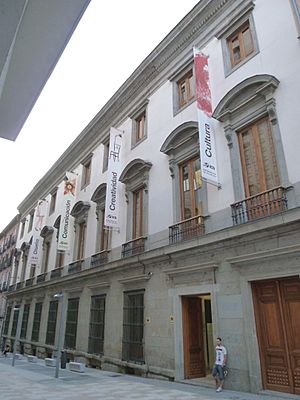Palace of Altamira (Madrid) facts for kids
Quick facts for kids Palace of Altamira |
|
|---|---|
| Native name Spanish: Palacio de Altamira |
|
 |
|
| Location | Madrid, Spain |
| Official name: Palacio de Altamira | |
| Type | Non-movable |
| Criteria | Monument |
| Designated | 1977 |
| Reference no. | RI-51-0004248 |
| Lua error in Module:Location_map at line 420: attempt to index field 'wikibase' (a nil value). | |
The Palace of Altamira (in Spanish: Palacio de Altamira) is a beautiful old building in Madrid, Spain. It's located on Calle de la Flor Alta, close to a big street called Gran Via. This palace was named a national monument in 1977, which means it's very important to Spain's history. A famous architect named Ventura Rodríguez designed it in 1772 for a noble family, the Counts of Altamira.
Contents
Where is the Palace of Altamira?
The Palace of Altamira was a very large building. It took up a whole city block! This area was popular for important families to live in. Many rich and noble people built their homes here. The palace had sides facing several streets, including Flor Alta and San Bernardo.
Why Was the Palace Not Finished?
Building the palace started in 1788. The next year, a model of the finished palace was shown to King Charles IV. The king was amazed by how grand it looked. He worried that this new palace would be even more magnificent than his own royal palace, which was nearby.
Because of this, the king started to make it difficult for the building work to continue. In the end, only a small part of the original design was built. Some people say the changes were simply because of money problems. The original plans included:
- A huge staircase
- Two courtyards, one with French-style gardens
- A large oval-shaped chapel
None of these grand ideas were ever built.
What Happened to the Palace?
Over time, the palace changed. In 1887, an architect named Mariano Belmas worked to make the building look more complete. He especially fixed parts of the outside that were unfinished.
By the 1900s, the inside of the palace was divided into many smaller offices. Later, these offices closed, and the building was empty for more than ten years. It became very run-down.
Finally, the palace was completely restored. This big project was led by Gabriel Allende Gil de Viedma. Since October 2005, the palace has been home to the Istituto Europeo di Design. This is a school where students learn about design.
Who Owned the Palace?
One famous owner of the palace was Vicente Osorio de Moscoso y Ponce de León. He was a very important noble. He had many titles, like Count of Altamira and Duke of Sessa.
He was known for having one of the largest art collections in Spain. He kept many valuable paintings in the palace. When he wrote his will in 1861, he listed all the amazing artworks he owned. He left several paintings by famous artists like Goya and Federico Madrazo to Queen Elizabeth II. His collection also included works by Rubens and Velázquez.
See also
 In Spanish: Palacio de Altamira (Madrid) para niños
In Spanish: Palacio de Altamira (Madrid) para niños

